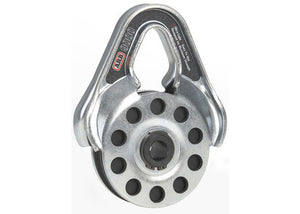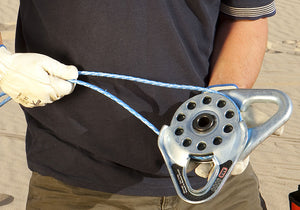Your Cart is Empty
Bergetools - Your shop for 4x4 off-road accessories - suitable for your vehicle and your projects
Bergetools - Your shop for 4x4 off-road accessories - suitable for your vehicle and your projects


ARB 9000 deflection pulley 9t WLL, 17.5t BL
One of the few steel pulleys that you can also recommend with a clear conscience for plastic ropes.
My favorite pulley among the classic pulleys. Around 1 kg lighter than most other steel pulleys, higher working and breaking load and due to the design there is no risk of a plastic winch rope getting stuck between the pulley and the side and thereby being destroyed, as has unfortunately been seen several times with simple steel pulleys or ARB replicas.
ARB 9000 in use ARB Youtube
pulley
Using a deflection pulley, the pulling force of a winch is doubled or the winch only has to provide half the power to tow a vehicle free. In return, towing only takes place at half speed.
The use of a deflection pulley, also known as a snatch block, always makes sense when considerable pulling force is necessary to recover a vehicle, for example when the underbody of the vehicle rests on the ground and all wheels rotate freely.
Because the winch only has to pull with half the force when using a deflection pulley, it also uses significantly less electricity. With a pulling force of 8,000 pounds, a winch with a maximum pulling force of 12,500 pounds needs 246 amps, with 4,000 pounds it only needs 154 amps. A conventional alternator cannot provide such currents, but a significant proportion of them comes from the battery, especially when idling. In addition, the higher the current that flows through the cable from the battery to the winch, the higher the voltage drop on the cable. And this results in lower engine performance. For example, for a 3 meter long cable (6 meters there and back) with a 25 mm² cross section, the voltage drop at 245 amps is 1.03 volts.
A deflection pulley is used as follows: The winch rope is unwound to twice its length, placed around the deflection pulley, led back to the vehicle and hooked onto it. The pulley is attached to a tree or other secure anchor point using a shackle and a tree anchor strap, for example.
Another advantage: The specified maximum pulling force of the winch is only achieved on the last layer of the winch rope, i.e. the longer the rope length is used, the higher the actual pulling force.
I only recommend simple steel pulleys (like those from Horntools or T-Max) for winches with steel cables. If a plastic rope is used, there is a risk that the rope will get stuck between the side wall and the pulley and be destroyed. This risk does not exist with high-quality steel pulleys such as ARB 9000 and Bushranger RBS11.
With synthetic rope, I personally only use so-called pulleys such as NMP or the Factor55 with Rope Retention System.